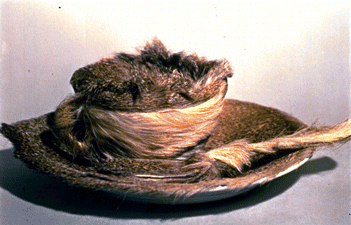Texture
|
| Texture refers to the way a surface feels when you touch it, such as rough or smooth. |
| Actual or tactual textures are what you feel when you touch things. Actual surfaces are an important feature of three-dimensional artworks. For example, in architecture and interior design, smooth materials such as glass, metal, or polished stone may seem to be harsh or cold. The actual weave of fabrics, wood grains and other materials often make a space or building feel more inviting or warm. In some two-dimensional arts - such as weaving, painting and collage - surface qualities are created by the way a material is used. For example, fibers can be chosen for their weave. They can also be woven so there is another variation of raised or lowered surfaces. |
|
Visual textures are the illusion of actual ones. There are many ways to create them. They can be simulated or invented. Simulations are seen in two-dimensional art such as photographs, paintings or drawings, where they look like the actual feel of fur, velvet, grass and the like. You see many simulated surfaces in daily life. Smooth plastic tables may look like wood. Plastic may be spray-painted to look like cloth. |
| In painting, thick layers of paint can be used to create textury qualities. This technique, called impasto, is often used with oils, acrylics and encaustic (wax-based paint). Sometimes paint is combined with other materials such as fine sand, sawdust or collage to make actual graininess. |
| Invented patterns are arrangements of lines, values and shapes that you see as real surfaces. Very small repeated patterns can used to do this. |
Artists also speak of materials as hard or soft. You can only experience these qualities by pressing or shaping a material, manipulating its surface qualities. |
| Surfaces can also be described by the way they reflect light, such as matte or glossy. A matte surface absorbs light, so it looks dull. Glossy surfaces are shiny. They reflect light and glisten. |
| In ceramic art, a work may be rough or smooth and be finished in a matte or glossy glaze (reflective surface). A semi-gloss paint is halfway between a very shiny surface and a dull, or flat paint. Photographs can be printed on glossy or matte surfaces. The paper itself may be smooth or have a subtle surface. |
Using different ways to create the illusion of hard and soft surfaces has fascinated many artists. A painting or other art form that imitates the surfaces of other materials is called a trompe l’oeil work, which is French for “fool the eye.” Many artists have developed techniques for inventing surface qualities with paint and in printmaking. A few are noted here. |
| |
RUBBINGS
Place paper over a rough surface and hold it firmly. Then rub the paper with the flat side of a crayon or piece of chalk or charcoal. |
FROTTAGE
Apply a layer of fresh paint on a canvas or paper. Place the canvas or paper paint-side up over a rough or grainy surface. Scrape the paint with a flat tool. This will leave a pattern like the surface below the painted canvas or paper.
|
GRATTAGE
Scratch into wet paint with a comb, a stiff piece of corrugated cardboard, or other tool. |
